2. Rayben Technologies (Zhuhai) Limited, Zhuhai 519180, Guangdong, China
With fast development of semiconductor technology, LED lamps and devices have become increasingly powerful. Being integrated and modularized, it undoubtedly adds to the heat accumulation during their lighting process[1-2]. As has been frequently reported, heat accumulation can increase LED junction temperature, thus leading to redshift of peak wavelength, deterioration of radiation flux, luminance flux, luminous efficiency, and other optical properties, which would finally affect the longevity and reliability of LED[3-6]. So it is of vital importance to perform efficient thermal management for LEDs to achieve ideal lighting effect. In LED lighting field, the selection of packaging materials with high thermal conductivity is critical. High thermally conductive Metal Core Printed Circuit Board (MCPCB) and ceramic such as AlN, BN, Al2O3, and Si3N4 are the most frequently used substrate materials[7-10]. Apart from acting the role of electricity connection, they are also expected to transport the heat generated during LED lighting from the chip to the external heatsink. In general, regular MCPCB is comprised of copper layer, insulating layer, and metal base. The insulating layer is fabricated using thermal conductive enforcement such as ceramic particle to fill polymer matrix, and the thermal conductivity of the matrix can be greatly enhanced in this way. Unfortunately, this method can merely increase the thermal conductivity to a certain level, which still does not suffice to meet the heat dissipation requirement of high power LED. Ceramics, which are inherently high thermally conductive, are theoretically adequate to be substrate material[11-12]. However, their high cost, fragility, and metallization difficulty restrict their further application. So it is pressing and necessary to search for cost down substrate materials of high thermal conductivity for heat dissipation of high power LED purpose.
In order to address the heat challenge which would adversely impact on LEDs' overall performance, a novel MHE MCPCB characterized by micro heat exchanger which functions as a rout for fast heat dissipation due to its unique structure design was introduced in this paper. Its heat dissipation performance in LED lighting was compared with that of 4 W/(m·K) regular MCPCB in search of substrate alternative to meet the heat dissipation requirement of high power LED.
2 ExperimentSimilar to regular MCPCB, this novel one also comprises copper layer, insulating layer, and metal base as illustrated in Fig. 1. The only difference is that this novel MCPCB possesses a 3.1 mm ×4.5 mm×0.135 mm micro heat exchanger etched with a copper base that penetrates the insulating layer and copper layer. In other words, the micro heat exchanger and copper base are integration of the same material. In practical application, the LEDs are supposed to be mounted on these micro heat exchangers to realize effective heat conduction while the FR4 part is merely where the circuit pattern is formed for electricity connection.
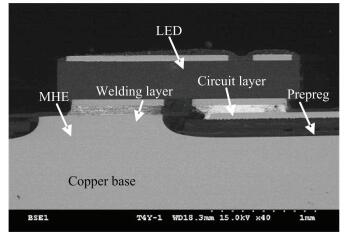
|
Fig.1 Schematic diagram of MHE MCPCB |
As illustrated in Fig. 2, a junction temperature test was performed to investigate the heat dissipation performance of metal core printed circuit board with micro heat exchanger. Firstly, the 13W XTE LEDs were mounted on regular MCPCB and the above-mentioned PCB employing SMT technology respectively to prepare modules with the void ratio controlled within 5%. Secondly, both modules were fixed on thermostat to keep the temperature on bottom side of each PCB constant at 25±1℃. Thirdly, the junction temperature of LED was measured using junction temperature tester.

|
Fig.2 Illustration of LED junction temperature measurement |
In order to further investigate how heat dissipation performance affects LED's optical properties, both regular MCPCB and MHE MCPCB were applied to dissipate heat for 25 W LED automobile lamp, with investigation of color temperature, luminous flux, luminous efficiency, peak wavelength, and dominant wavelength using integrating sphere system as shown in Fig. 3.
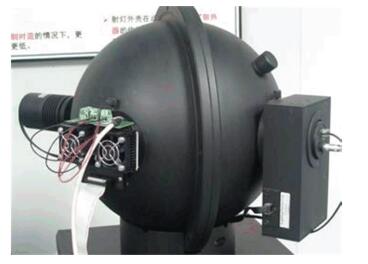
|
Fig.3 Optical property investigation employing integrating sphere |
3 Results and Discussion
Fig. 4 represents the junction temperature curves of LED employing 4 W/(m·K) and MHE MCPCB for heat dissipation. It can be clearly observed that when the temperature at the bottom side of both PCB was fixed constant at 25±1 ℃, LED with 4 W/(m·K) regular presents junction temperature of 73.14 ℃. By comparison, LED with MHE MCPCB presents junction temperature of 49.72 ℃. Therefore, it is deduced that MHE MCPCB is much more thermally conductive than 4 W/(m·K) regular MCPCB. Actually, this phenomenon can be ascribed to thermal contact resistance which was formed on the interface between copper and resin[6].
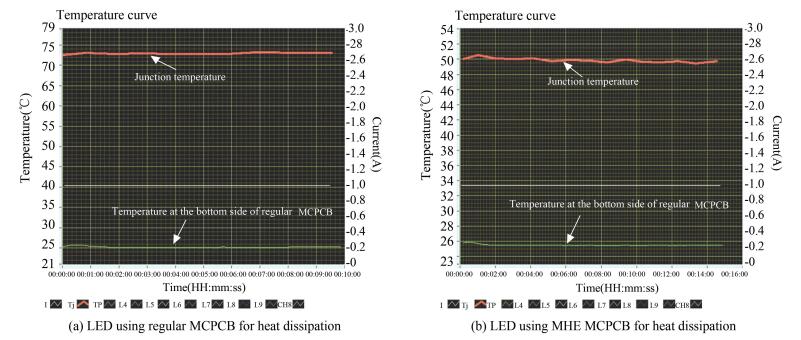
|
Fig.4 Junction temperature curves of the same type LED |
Generally, copper depends mainly on the movement of free electron and secondarily on phonon propagation to spread heat. Resin relies solely on phonon propagation to realize heat transportation. Since copper and resin are totally different materials, the crystal lattices on both sides of the interface are discontinuous. Meanwhile, interface is the place where impurities and defects are concentrated, which would cause phonons to scatter[13]. So when heat flux q flows across the resin-copper interface, a great part of phonons will be scattered, thus creating a thermal contact resistance TCR[14]. Because of the formation of thermal contact resistance, there would be a temperature drop ΔT on both sides of the interface. The value of thermal contact resistance can be determined by equation TCR=ΔT/q[13]. The thermal contact resistance existing on the interface greatly contributes to the deterioration of heat dissipation performance of PCB. In terms of regular MCPCB as illustrated in Fig. 5, it is comprised of circuit layer, insulating layer, and metal base. The heat flux generated by LED is expected to transfer from circuit layer to insulating layer, then from insulating layer copper base and then from copper base to the external heatsink. As has been reported in Ref.[15-16], the difference of thermal conductivity between copper and resin is huge, which might cause a big temperature drop on their interface, thus leading to a big thermal resistance according to thermal contact resistance equation. Different from regular MCPCB, MHE MCPCB can transport heat generated effectively by LED through the micro heat exchanger to the external heatsink because the heat flux would preferentially choose to spread along the rout of least thermal resistance under normal circumstances. Since there exists thermal contact resistance on copper-resin interface which is much bigger than that of copper, a great amount of heat is confined within the region surrounded by the copper-resin interface and dissipated through the micro heat exchanger, which greatly enhances the thermal conductivity of the MHE MCPCB.
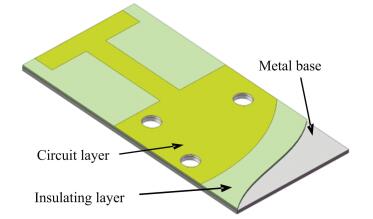
|
Fig.5 Schematic diagram of regular MCPCB |
Fig. 6 represents the optical spectra and spectral chromaticity coordinates of both LEDs. Table 1 reveals the color temperature, luminous flux, radiation flux, luminous efficiency, peak wavelength, and dominant wavelength information of LEDs investigated by integrating sphere system. It is evident that LED mounted on MHE MCPCB presents improved luminous flux, radiation flux, and luminous efficiency when compared with that mounted on regular MCPCB, which can be attributed to the fact that when MHE MCPCB was used to dissipate heat for LED, the junction temperature was 23.42 ℃ lower than that of LED using regular MCPCB to dissipate heat.
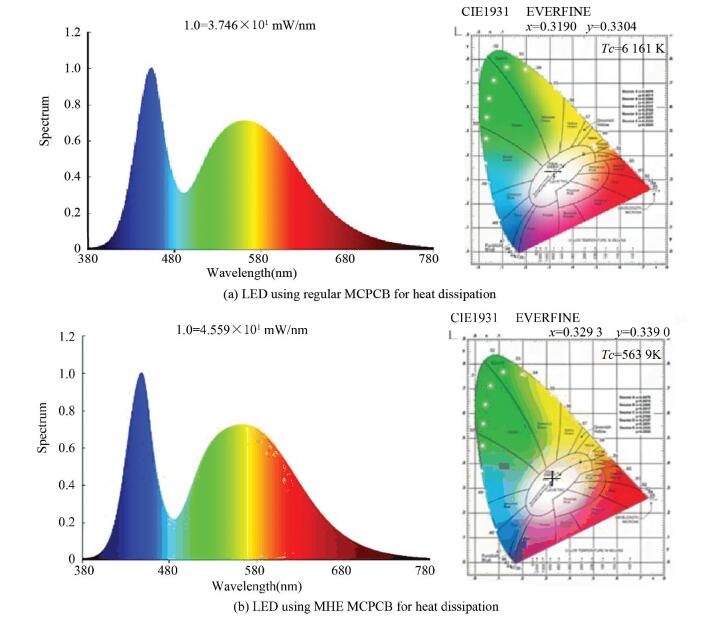
|
Fig.6 Spectrum and chromaticity diagram of the same type LED |
| Table 1 Optical properties of LED using regular MCPCB and MHE PCB for heat dissipation |
Normally, MCPCB with enhanced thermal conductivity leads to faster heat dissipation of LED with decreased junction temperature. Moreover, when LED junction temperature decreases, its comprehensive optical performance will be greatly improved. From Table 1, it is easy to find that lower LED junction temperature leads to higher luminous flux, increased radiation flux, and enhanced luminous efficiency. This phenomenon can be attributed to electro-optical conversion efficiency enhancement linked to decreased junction temperature[17-18]. As the junction temperature decreases, the radiation recombination efficiency of blue LED increases accordingly, which improves electro-optical conversion efficiency, thus leading to increment of blue light radiation[19-20]. Additionally, the temperature of phosphor layer coated on blue LED decreases with the decline of LED's junction temperature, producing an increased fluorescence efficiency, which contributes to increment of luminous flux, radiation flux, and luminous efficiency[21].
In contrast with LED employing regular MCPCB for heat dissipation, it is also easy to find that when MHE MCPCB was applied, the dominant wavelength was increased by 22.6 nm, the color temperature decreased by 552 K, and the peak wavelength underwent a blue shift of 0.7 nm. As has been pointed out, color temperature is determined by LED junction temperature. Namely, decreased junction temperature leads to dropped color temperature which is inclined to be warm[22]. Since the dominant wavelength is corresponding to the visually accessible light, the increment of dominant wavelength signifies the wavelength of visible light shed by the increased and warmer white LED, which is in agreement with decrement of color temperature. In addition, the LED junction temperature decreased when MHE MCPCB was used for heat dissipation, which would slow down co-movement of free electron in crystal and alleviate the splitting of energy level, resulting in a widened band gap. According to wavelength equation λ=1 240/Eg[23], peak wavelength was shortened. Namely, peak wavelength underwent blue shift.
Since white LED is produced by coating phosphor that can shed yellow light to coat on blue chip, and the white light can be obtained when blue light mixes up with yellow light, the peak wavelength corresponds to the blue light. According to junction temperature measurement, the junction temperature of LED with MHE MCPCB is 23.42 ℃ lower than that of LED with regular MCPCB, and the peak wavelength difference is 0.7 nm. So it can be calculated that the LED average temperature coefficient of wavelength shift is 0.029 89 nm/℃, which is in agreement with 0.028 57 nm/K-0.039 29 nm/K reported by Ref.[24].
4 ConclusionsMHE MCPCB is more thermally conductive than regular MCPCB due to its unique design of micro heat exchanger structure. Because of the presence of interface thermal resistance, a great amount of heat generated by LED is confined within micro heat exchanger and spreads through it to external heatsink, thus possessing a much better heat dissipation performance in comparison with regular MCPCB, which is capable of great enhancement of LED's comprehensive optical performance.
| [1] |
Qin D C, Li B Z, Huang Y Z, et al. Interface morphology and thermal conductivity of ceramic-embedded FR4 structure. Semiconductor Technology, 2017, 42(11): 864-869. DOI:10.13290/j.cnki.bdtjs.2017.11.011 (  0) 0) |
| [2] |
Pulavarthy R A, Haque M A. A novel technique for Interfacial Thermal Resistance measurement for nanoscale thin films. International Journal of Heat and Mass Transfer, 2015, 89: 743-748. DOI:10.1016/j.ijheatmasstransfer.2015.05.088 (  0) 0) |
| [3] |
Zhang S U. Chip package interaction for LED packages. Microelectronics Reliability, 2016, 63: 76-81. DOI:10.1016/j.microrel.2016.06.014 (  0) 0) |
| [4] |
Wua H H, Lin K H, Shun-Tian Lin S T. A study on the heat dissipation of high power multi-chip COB LEDs. Microelectronics Journal, 2012, 43(4): 280-287. DOI:10.1016/j.mejo.2012.01.007 (  0) 0) |
| [5] |
Yang K S, Chung C H, Tu C W, et al. Thermal spreading resistance characteristics of a high power light emitting diode module. Applied Thermal Engineering, 2014, 70(1): 361-368. DOI:10.1016/j.applthermaleng.2014.05.028 (  0) 0) |
| [6] |
Qin D C, Chen A B, Xiao Y L, et al. Preparation of anodic alumina substrate and its application in LED heat dissipation. Journal of Synthetic Crystals, 2018, 47(1): 225-230. DOI:10.16553/j.cnki.issn1000-985x.2018.01.037 (  0) 0) |
| [7] |
Hu Y, Du G P, Chen N. A novel approach for Al2O3/epoxy composites with high strength and thermal conductivity. Composites Science and Technology, 2016, 124: 36-43. DOI:10.1016/j.compscitech.2016.01.010 (  0) 0) |
| [8] |
Fu Y X, He Z X, Mo D C, et al. Thermal conductivity enhancement of epoxy adhesive using graphene sheets as additives. International Journal of Thermal Sciences, 2014, 86: 276-283. DOI:10.1016/j.ijthermalsci.2014.07.011 (  0) 0) |
| [9] |
Kim K, Kim J. Magnetic aligned AlN/epoxy composite for thermal conductivity enhancement at low filler content. Composites Part B:Engineering, 2016, 93: 67-74. DOI:10.1016/j.compositesb.2016.02.052 (  0) 0) |
| [10] |
Jang I, Shin K H, Yang I, et al. Enhancement of thermal conductivity of BN/epoxy composite through surface modification with silane coupling agents. Colloids and Surfaces A: Physicochemical and Engineering Aspects, 2017, 518: 64-72. DOI:10.1016/j.colsurfa.2017.01.011 (  0) 0) |
| [11] |
Qin D C, Li B Z, Xiao Y L. Current status and development of ceramic metallization. China Ceramic Industry, 2017, 24(5): 30-36. DOI:10.13958/j.cnki.ztcg.2017.05.005 (  0) 0) |
| [12] |
Yu C P, Zhang J, Li Z, et al. Enhanced through-plane thermal conductivity of boron nitride/epoxy composites. Composites Part A: Applied Science and Manufacturing, 2017, 98: 25-31. DOI:10.1016/j.compositesa.2017.03.012 (  0) 0) |
| [13] |
Shi L, Mi T, Liu Y X. Phono transmission coefficient of the solid-solid thermal contact conductance. Cryogenics and Superconductivity, 2006(3): 176-178. DOI:10.16711/j.1001-7100.2006.03.008 (  0) 0) |
| [14] |
Shi L, Yu X M, Wang H L, et al. The investigation of solid-solid contact interface thermal transfer. Cryogenics and Superconductivity, 2008(10): 19-22. DOI:10.16711/j.1001-7100.2008.10.001 (  0) 0) |
| [15] |
Qin D C, Chen A B, Xiao Y L, et al. Influence of thermal spreading resistance on thermal dissipation property of FR4/AlN composite. Semiconductor Optoelectronics, 2018, 39(03): 385-388. DOI:10.16818/j.issn1001-5868.2018.03.018 (  0) 0) |
| [16] |
Qin D C, Liang K W, Chen A B. Preparation of copper substrate with electrical path and its application in LED's heat dissipation. Semiconductor Optoelectronics, 2018, 39(4): 544-548. DOI:10.16818/j.issn1001-5868.2018.04.019 (  0) 0) |
| [17] |
Cui Z Y, Gu Q B. Research on LED light source lumens depreciation rule. Semiconductor Technology, 2012, 37(4): 312-315. DOI:10.3969/j.issn.1003-353x.2012.04.015 (  0) 0) |
| [18] |
Liu L M, Zheng X D. Measurements of LEDs spectral characteristics and junction temperature. Acta Photonica Sinica, 2009, 38(5): 1069-1073. (  0) 0) |
| [19] |
Wu H B, Wang C L. Experimental research on influence of packing materials of white LED on its luminous decay. Acta Optica Sinica, 2005(8): 1091-1094. (  0) 0) |
| [20] |
Zhang L Y, Zhou L, Zhang J Y, et al. Research on mechanism of high-power LED luminous attenuation. Semiconductor Technology, 2009, 34(5): 474-477. (  0) 0) |
| [21] |
Fei X, Qian K Y, Luo Y. Junction temperature measurement and luminous properties research of high-power LED. Journal of Optoelectronics:Laser, 2008(3): 289-292, 299. DOI:10.16136/j.joel.2008.03.013 (  0) 0) |
| [22] |
Liang T J, Zhang F H, Qiu X Z, et al. The influence of junction temperature on the spectral characteristics of white LED with low color temperature and high color rendering index. Journal of Functional Materials, 2012, 43(24): 3389-3392. (  0) 0) |
| [23] |
Hu C Q, Zhang F H, Zhang J. The spectral and junction temperature properties of new white light LED. Chinese Journal of Luminescence, 2012, 33(9): 939-943. DOI:10.3788/fgxb20123309.0939 (  0) 0) |
| [24] |
Zhong W J, Wei A X, Zhao Y. Dependence of GaN-based white LED colorimetric parameters on junction temperature. Chinese Journal of Luminescence, 2013, 34(9): 1203-1207. DOI:10.3788/fgxb20133409.1203 (  0) 0) |
 2020, Vol. 27
2020, Vol. 27


